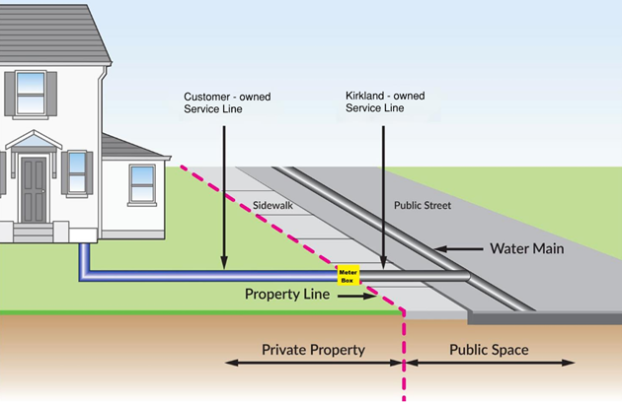Lead and Copper Rule Revisions

In 2021, to try to significantly lower the risk of exposure to lead and copper in our nation’s drinking water, the US EPA implemented the Lead and Copper Rule Revision (LCRR). This included a requirement for all public water systems to complete an inventory verifying that both public and private water service lines are not made of lead. Kirkland has submitted the baseline inventory to Washington State Department of Health (DOH) by the due date, October 16, 2024.
Results
No lead service lines were discovered within the City of Kirkland water service area. A map of service line materials by address can be found at the Service Line Material Public Viewer.
The work to verify the service lines has been a significant undertaking, and we are pleased to report no lead service lines were discovered within Kirkland’s water service area.
There are multiple water utilities operating in the City of Kirkland. If you are located outside of the City of Kirkland water service area, please contact your water service provider for information about the water service line inventory. Find your water provider.
Methodology
The use of lead pipes has not been allowed in Kirkland since 1968 when the King County code was adopted. The use of pipes containing lead was prohibited at a federal level in 1986 and plumbing fittings and fixtures were required to be lead-free starting in 1996. Service lines for many of the homes and businesses within the City of Kirkland water service area were constructed after these bans. However, service lines constructed before 1968 required verification.
Physical Water Service Line Inspections
Approximately 3,300 properties in the Kirkland water service area were identified as being constructed in 1967 or earlier. For properties constructed in 1967 or earlier, we conducted a physical inspection using the DOH’s recommended statistical approach, which amounted to a subset of about 350 properties, to safely rule out any potential use of lead service lines. The statistical method is approved and strongly recommended by DOH for water systems that have not found lead service lines.
We plan to continue field inspections for service line materials during our routine maintenance and repair work conducted by field crew. To conduct physical inspections, we complete small excavations near water meters to identify service line material of both the system and private sides and restore the disturbed areas back to their original condition. The work does not interrupt water service and you do not need to be home.
We do not anticipate finding lead lines in our service area. However, if we discover lead service lines at your property, we will immediately notify the property owner.
For questions or concerns about LCRR, please contact us using Our Kirkland.
Frequently Asked Questions
Why is the City of Kirkland Collecting lead pipe information?
The Environmental Protection Agency (EPA) and Washington State Department of Health (DOH) adopted revisions to the Lead and Copper Rule, requiring public water systems to conduct inventories of service lines and identify service line material types. The service line inventory requirement is intended to identify service lines made of lead so they can be removed and replaced.
What will Kirkland do with this information?
The service line inventory will be shared routinely with Department of Health (DOH) and updated as parcels are developed, or service lines are uncovered for maintenance and repair.
What is a service line?
A service line is the pipe connection from a City of Kirkland water main under the street to a building. It is divided into the system (City) side and the customer side. The City owns the line from the water main to the water meter, including the meter setter. From the end of the meter setter to the building, the service line is the property and responsibility of the property owner, along with all the plumbing in the building.

What does Kirkland do to protect my household from lead?
Kirkland’s water provider, Seattle Public Utilities, adjusts the water’s chemistry at the treatment sites to prevent lead from dissolving into water from lead service lines or home plumbing. This process is known as corrosion control. Although corrosion control can reduce risks, the best way to ensure your home is safe from lead exposure through water is to remove any potential lead sources. Information on lead in drinking water, testing methods, and steps you can take to minimize exposure is available from the Safe Drinking Water Hotline.
More information on the Rule can be found at:
US EPA - Lead and Copper Rule Revision
WA Department of Health - Lead and Copper Rule